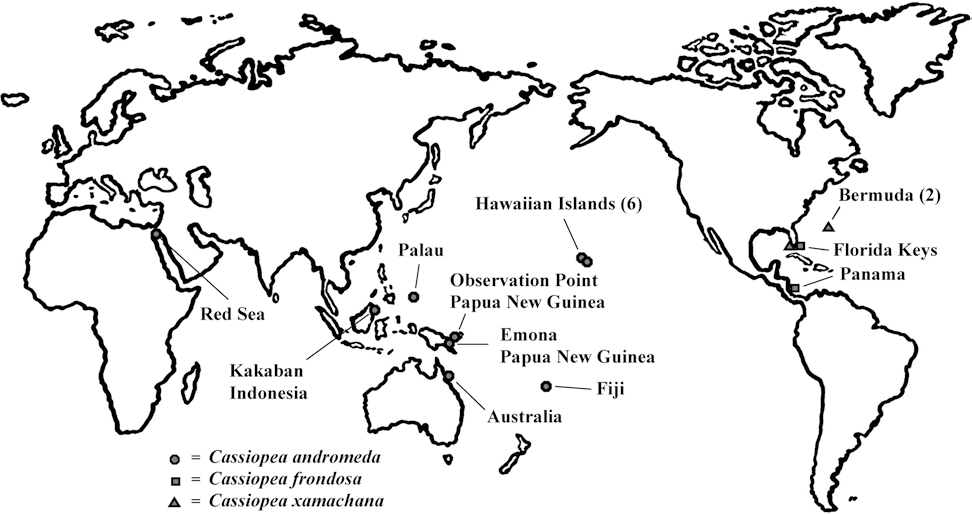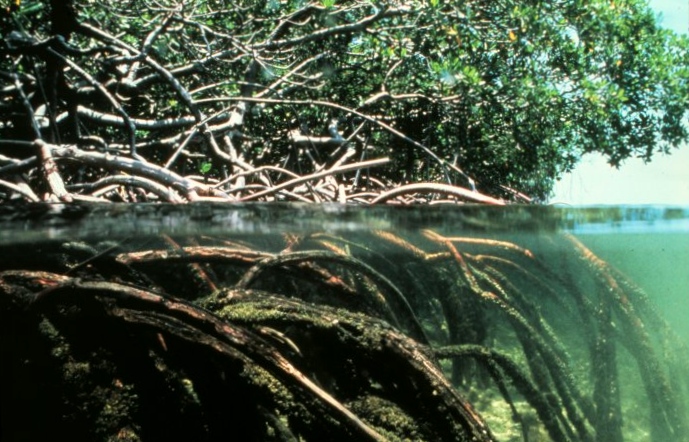Habitat
Cassiopea xamachana, like any other organism, lives in a unique
habitat that helps it succeed. It just so happens that these
well-suited habitats are found globally (Holland et al. 2004).
Even so, a majority of the upside-down jellyfish are found in
the Caribbean Sea (McGill et al. 2008), which is located between
Mexico, the Caribbean Islands, and northern South America.
 After
World War II, United States naval ships transported and
introduced the organism to the Hawaiian Islands (Holland et al.
2004). Like most marine life, Cassiopea xamachana like to stay
in close proximity to the equator. This is where the maximum
amount of sunlight is found year round, which makes it the
warmest place to call home (Holland et al. 2004).
After
World War II, United States naval ships transported and
introduced the organism to the Hawaiian Islands (Holland et al.
2004). Like most marine life, Cassiopea xamachana like to stay
in close proximity to the equator. This is where the maximum
amount of sunlight is found year round, which makes it the
warmest place to call home (Holland et al. 2004).
The upside-down jellyfish are found dwelling in the
benthic zone, which is the bottom of any water source- along the
surface of the sediment.
The
shallow waters of the benthic zone are where they can bask in
the sunlight, they are protected from predators, and the water
is calm (Holland et al. 2004). They will rest on the bell of
their body presenting their arms towards the rays from the sun.
Their lifestyle is much like that of other organisms that reside
in the benthic area (Santhanakrishnan et al. 2012).
One of these
attributes includes being semi sessile, meaning that they rarely
swim. Because they are semi sessile, it is best not to remove
them from their habitat. A small amount of flow or velocity in
the water is needed to bring them nutrients (Santhanakrishnan et
al. 2012). This makes it vital that they live in nutrient rich
ecosystems. The upside-down jellyfish can create their own flows
in the water with their arms (Santhanakrishnan et al. 2012).
Despite them being generally sessile creatures, they are
actually skilled swimmers. The jellyfish and their progeny can
travel by means of larval dispersal, migration, and even rafting
(Holland et al. 2004).
meaning that they rarely
swim. Because they are semi sessile, it is best not to remove
them from their habitat. A small amount of flow or velocity in
the water is needed to bring them nutrients (Santhanakrishnan et
al. 2012). This makes it vital that they live in nutrient rich
ecosystems. The upside-down jellyfish can create their own flows
in the water with their arms (Santhanakrishnan et al. 2012).
Despite them being generally sessile creatures, they are
actually skilled swimmers. The jellyfish and their progeny can
travel by means of larval dispersal, migration, and even rafting
(Holland et al. 2004).
Cassiopea xamachana are more likely to be found in waters that
are close to the shore than they are in a marine ecosystem. An
example of a shallow environment where one might find Cassiopea
xamachana is a mangrove dominated habitat that grows along the
coastal sediment (Holland et al. 2004).
 The mangrove leaves that have fallen into the water play a large
role in the reproduction of the upside-down jellyfish. Cassiopea
xamachana’s common name of “mangrove jellyfish” comes from being
found so frequently in the mangrove habitat (Holland et al.
2004). A mangrove habitat can have a sandy mudflat, which
during low tide has a few inches of water, never becoming
totally dry. Sandy mudflats are a favorite place to call home
among the inshore marine waters for Cassiopea xamachana because
the water is usually clear. Clear, shallow water allows the
dinoflagellates living on Cassiopea to do photosynthesis; this
is how the upside-down jellyfish get their energy. This is why
the best spot to search for the upside-down jellyfish is in
shallow, tropical, sandy mudflats (Holland et al. 2004). Corals
are another great place to look for Cassiopea xamachana because
the coral are symbiotic organisms. The coral provides food and
protection from predators for the upside-down jellyfish. While
resting on its bell among the coral, Cassiopea xamachana looks
like it is part of the coral (Thornhill et al. 2006).
The mangrove leaves that have fallen into the water play a large
role in the reproduction of the upside-down jellyfish. Cassiopea
xamachana’s common name of “mangrove jellyfish” comes from being
found so frequently in the mangrove habitat (Holland et al.
2004). A mangrove habitat can have a sandy mudflat, which
during low tide has a few inches of water, never becoming
totally dry. Sandy mudflats are a favorite place to call home
among the inshore marine waters for Cassiopea xamachana because
the water is usually clear. Clear, shallow water allows the
dinoflagellates living on Cassiopea to do photosynthesis; this
is how the upside-down jellyfish get their energy. This is why
the best spot to search for the upside-down jellyfish is in
shallow, tropical, sandy mudflats (Holland et al. 2004). Corals
are another great place to look for Cassiopea xamachana because
the coral are symbiotic organisms. The coral provides food and
protection from predators for the upside-down jellyfish. While
resting on its bell among the coral, Cassiopea xamachana looks
like it is part of the coral (Thornhill et al. 2006).
